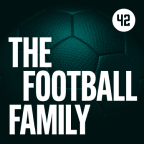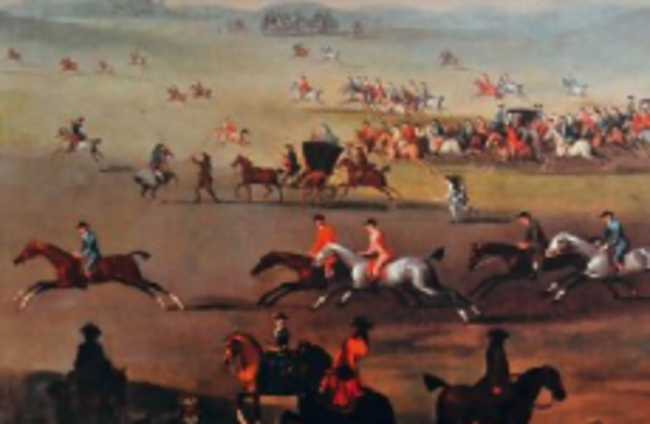MANY PEOPLE ASSUME sport in Ireland effectively began with the establishment of the GAA, however this is far from the case.
A new book by Professor James Kelly, ‘Sport in Ireland: 1600–1840,’ looks at this lesser known period in considerable detail, with a wide variety of sports analysed, including hunting, horse racing, cockfighting, wrestling and bull baiting.
Kelly, who is Cregan professor of history at St Patrick’s College, DCU, explains how the idea to write the book largely came about owing to the conspicuous lack of existing material on the subject matter.
“I used to go along to meetings of the sports history society and noticed that there was very little on the subject before the GAA,” he tells TheScore.ie. “My main area of focus is the history of the 17th, 18th and 19th century, and I knew there were things going on then, so my idea was to make sense of that. I was driven by a desire to demonstrate that people did play sport before organised football.”
Yet it was perhaps no surprise that not much had been written about sport in Ireland pre-1850 — the recording of such events was sketchy at best. And ultimately, Kelly undertook the painstaking process of carefully rooting through countless old newspapers, among other sources, in search of further details.
Many of the reports he found were short and not particularly descriptive, while certain eminent sports such as horse racing received far more extensive and favourable coverage, compared with supposedly disreputable activities, including cockfighting.
“When [cockfighting] became controversial towards the end of the century, you get longer accounts,” he explains. “Most of the descriptions are negative and I put those together. And the cockfighting chapter, believe it or not, is one of the more satisfying chapters, because cockfighting began in the 18th century and ends in the 18th century as well. Towards the end of the century, people began to regard it as cruel, unusual and unnatural. So it comes to an end.”
While the book focuses on sport, its interests are deeper than the mere description of “who won,” as Kelly puts it.
“I’m more interested in the society and what it tells you about the people who play it. Truth be told, the things we like and the things we do says something about ourselves. In a sense, one was using the sport as a means of actually analysing the society and also tracking and tracing the impulse to play in different shapes and different forms — the impulse to play is timeless, I suspect our ancestors in the cave were involved in play of some kind, but I’ve no idea what form it took.”
One of the most striking aspects of Kelly’s book, from a modern perspective, is the sheer cruelty and complete apathy that the people of those times showed towards animals. In one particularly gruesome passage, an organised fight between a cat and a cock is described in detail.
(John Langan was the finest Irish pugilist, and a worthy challenger of Tom Spring, the ‘champion of England’ — steel plate engraving plate from a collection of engraved plates, c.18.40, originally published in Pierce Egan, Boxiana, or sketches of ancient and modern pugilism, London 1812-20: author’s collection)
“There was no sense that animals had feelings. There was no sense that animals felt pain. Animals effectively were playthings or sources of food. They were there for human beings to exploit. If you look at the theology of main religions, which guide people’s thinking, the assumption is that the role and purpose of animals is to serve human beings.
“If you take that attitude then in practical terms, you can legitimate and justify everything. It doesn’t seem logical that human beings should ride horses one against the other and see which one is the fastest. But that’s quite a sophisticated practice. It’s perhaps less sophisticated that you ride a horse around the country chasing after another animal, which is what deerhunting was – foxes, otters and other animals were also pursued.”
He continues: “When you look at the phenomenon of bear-baiting, which there was very little of in Ireland, it’s actually cruel and abusive. An animal is going to die in the course of that.
“If there was a person that pursued hunting, he would argue that it’s not just the thrill of the chase, but that the sheer amount of pain inflicted on the fox is short. But no such claim can be made about bull-baiting or bull-running, which took place in Dublin. The longer it went on, the more people enjoyed it, and at the end of the day, people would say that was a good day’s bull-baiting for the simple reason that it lasted all day.”
Yet it was not only the animals that had it tough. Irish people, in general, worked long hours in physically demanding jobs, with such savage entertainment serving as a rare means of release from the mundane tasks of everyday living.
“If you were an artisan, a journeyman or an apprentice in a workshop in Dublin or Cork or Wexford in the 18th century, you worked from dawn till dusk. Your liberty was defined for at least seven years because the articles of apprenticeship meant that you had to do as your master ordered.
“There were a couple of days a year that you had off — maybe Sunday afternoons. You might be allowed go to worship but you didn’t have much time. You were being treated harshly. And you assumed that the way the world operated wasn’t a world of sophistication and fine feeling.”
Moreover, as it continues to do nowadays, the press played a vital role in accentuating the popularity of certain sports, while also prompting interest to wane in others through a lack of coverage or negative publicity.
“The newspaper was critical in the dissemination of information,” Kelly explains. “You couldn’t have had cock-fighting in the manner in which that took place. But most importantly of all, you couldn’t have had horse racing.
“One of the most lucrative race weeks was in Boyle in the 1750s. The Earl of Kingsborough basically provided very high funds. He came to advertise in newspapers, so months ahead of the game, he’d indicate that the race would take place in Boyle at the end of July. And those who wished to enter horses should contact whoever… So it indicated how many races were going to take place, the length of the race, what the entry was, which was partly to prevent cheating et cetera.”
One of the big differences between horse racing then and now was its length, with some races lasting several miles, and representing a test of endurance more than anything else. Moreover, the scene at the races would not be overly dissimilar from say, a Leinster Rugby match today, as beer and various alternative forms of entertainment, such as card games, were a prominent part of the day’s activities. So already, the modern-day tendency to combine business and sport was clearly apparent as early as the 18th century.
Yet while horse racing was inextricably linked with the more well-off members of society, the common man’s game was undoubtedly cockfighting — to such an extent that county teams were eventually set up.
“So you could have the gentleman of Antrim playing the gentleman of Armagh,” Kelly explains. “And there were cockpits being built all over the place. These weren’t great sophisticated buildings. The pity is that none of them are left. Somebody said we’ll have a particular cockpit and there’d be tiered seating around it so you could come and view and pay in to it.
“Cockfighting could last a week. The newspapers reported that there’d be a cockmatch in Newry or Antrim town or Dublin or wherever. The biggest cockpit was located where the City Hall is now. That was the central cockfighting area in Ireland.”
However, as Ireland developed into a stricter, more religious and ethical society, people gradually and unsurprisingly became less willing to tolerate the sport.
“By the 1780s, the mood was about to change. You get the rise of the Sunday schools. The rise of a view that this isn’t very decorous. This is built on cruelty and abuse. There’s hostility to betting. It’s predominantly male, though men are encouraged to bring their wives. The wives are provided with other entertainments. The men who are going there are drinking too much, if they’re in Dublin they may well be in the nearest bordello. And people began to think this isn’t a sport we should encourage.
“By the late 1780s and early 1790s, there were magistrates who found cockfighting to be as disagreeable an activity as gambling, as late-night carousing, as ill-behaviour that’s associated groups of men. It’s linked in with all sorts of other social abuses — things like suicide, violence and illegal activity and so on.”
Ultimately, a law was introduced, whereby a license is needed to partake in cockfighting, which reduces its accessibility and pushes it to the margins, causing this barbaric sport to gradually die out, before parliament officially makes it illegal in the early 19th century.
(The Westmeath Challenge Urn, London 1834, mark of Charles Reilly and George Storer. This large urn depicts a hunt in full flight. Sold at auction in October 2012 — image courtesy of Adam’s.)
“You can see the same thing happening with bull-baiting in Dublin. Bull baiting initially was just reported. As you move on in time, people are arguing ‘I want to do my business in the street, why have I got to put up with these louts and ruffians. They’re basically chasing a bull. The bull is terrified.’ Occasionally there are accidents or incidents in which people are getting injured on the grounds of ‘this is unsafe,’ ‘this is unprofitable.’ So just as the cockfighting is moved out of the cockpits and out of the bigger towns into the villages and the countryside, and then sort of ceases to exist, the same happens with bull-baiting.”
And again, the recurring theme of the media’s tendency to play an integral role in dictating events is palpable.
“I’m critical at times of people for berating the press and saying what they’re doing is wrong. Don’t get me wrong, I don’t like every story I read, but the press serves more actively as a mirror to society than it is leading society.
“That’s why the newspapers [I read in my research] were so helpful. There was some manuscript material. There was some private and personal material. But the majority of it comes from newspaper accounts.”
Furthermore, hunting was another popular sport, though as was predominantly the case, it was male-dominated.
“Women could have some involvement and could be brought along to horse racing and most thought it was boring. They were brought along to hunting, but most thought some of the gentries who were involved in the hunt were boors — and some of them were. All they thought about was their horses, their dogs and drinking in the evening. They weren’t exactly sophisticated men.
“It was a dangerous activity, because you could be chasing across fields and across hedges and ditches, but there were some women who were very good at horse racing. The assumption in aristocratic society was to be genteel. And women were expected to be genteel. If you weren’t behaving as society expected, well then somebody would take exception to you. It was all about marriage then, and marriage was a financial transaction as much as an emotional one. If somebody didn’t regard you as sufficiently well behaved, the dowry might not be acceptable. It was a society with all those sorts of attitudes.”
One other big difference between sport then and now was that, for many obvious reasons, it was virtually impossible for most athletes to acquire worldwide renown. Yet this didn’t mean they could not gain a certain level of local fame, and be significantly rewarded in the process.
“I dare say in terms of what has happened in the present, there were guys in Kilkenny or Tipperary who were particularly skillful as hurlers that were the talk of the town — there were allegedly football games and the captain of whichever team won got to choose which of the local girls could be his partner.
“It indicates that the skills some of these individuals had were valourised. That would seem a very alien basis from our perspective on which to base a marriage. But in an era in which people had to marry to their own social level, people had to bring a dowry, if you moved down a layer, the beautiful young woman of the community basically marries the best hurler in the locality. It’s revolutionary Darwinism of a type.”
(Racing at the Curragh, c.1730. This painting, by an unknown artist, illustrates the way in which racing was then conducted — original in private possession; this image is from the photograph in the Courtauld Institute, London; it is reproduced in John Feehan, Cuirreach Life: the Curragh of Kildare, Ireland, Dublin 2007)
Finally, I can’t finish without asking Kelly for his thoughts on the future of sport. As someone who would be well aware of the various patterns and changes it has undergone over recent centuries, he is a greater authority than most in terms of predicting its future course.
“The real impact of television on sport is impossible to tell,” he says. “We’re getting to a phase when you’d ask why would you go to see a game live. Today, we can sustain a situation where we have a live audience and a television audience. That’s the case for the big games, but the GAA is interesting in that regard, because the attendance at the league games is very modest. Croke Park is only full a few times a year. If you look at Serie A, the stadiums aren’t all the San Siro, they aren’t always getting crowds, when that crowd disappears as it will do in time, what will the outcome be?”
He believes sports such as boxing will continue to become more marginal, while horse racing — despite growing animal welfare-related complaints in recent years — could be safe in the short term at least.
“The reason the Grand National might survive longer than hunting will survive is that there is an economic rationale to it. As long as you can combine economic rationale with a popular rationale, then the activity will survive. When one of those or two of those go, it will all change.
“The other thing that the last century has demonstrated is the sheer amount of new sports, so I suspect new ones will become prevalent. And what will the impact of India, which has a billion people, be?
“So who’s to say that rugby and GAA and soccer will survive as the dominant sports into the future? In practice, football, American football, hurling, soccer, they’re all of a type in terms of a game. They’re going through their great period. But if we were back five centuries and we were rich, archery would be the big game, or falconry would be your game.”
‘Sport in Ireland, 1600-1840′ by James Kelly is out now. More details here.








